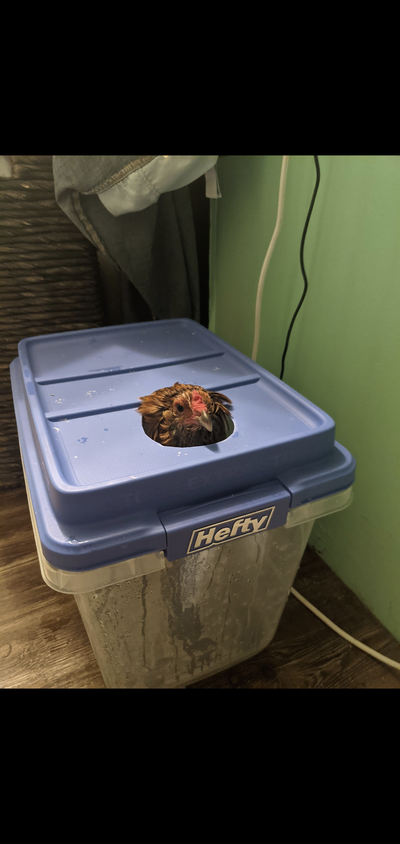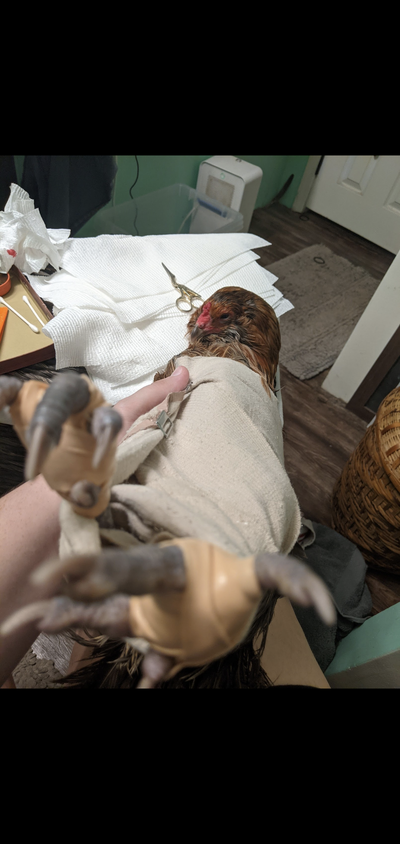Katakornchicks
Songster
- Oct 6, 2021
- 114
- 141
- 121
Hey folks. So bumblefoot is one ailment I've always struggled to treat within my flock, and I've never been able to find a way to do it successfully after many difficult (and mildly traumatic attempts) but finally, I've discovered the secret. A, dare I say it, EASY way! I've done this on 3 feet now and ALL have completely healed!! Here's what I did:
1: I take the chicken inside and wash BOTH feet (infected and not) with hot soapy water in my bathroom sink while I hold her in one arm like a baby. It's easy trust me.
2. I bought a plastic tub from Walmart with a snap down lid. I filled it at the bottom with a about 2-3 inches of warm water FILLED with Epson salt and sometimes a bit of rubbing alcohol. (Go easy on the rubbing alcohol because fumes.)
3. I cut a small hole in the plastic tubs lid, just enough for the hen to stand up and pop her head through for air, but not large enough for her to escape out of. I place the chicken in the tub with the warm Epsom water, snap on the lid, and set a timer for about 10-15 minutes and let her soak. I don't have to do anything. She just chills in there.
4. I remove my chicken, dry her off a bit, and now I restrain her and prep for surgery. For an easy restraint, I used an elastic cloth Ace bandage. I wrap it securly around both of her wings and torso multiple times, creating a lovely immobilized chicken burrito. ALSO if you are not operating on both feet, I HIGHLY recommend wrapping up the good foot against her chest along with her wings. It makes things SO much easier so she doesn't kick you while you are working on the bad foot.
5. Now for the fun part. Place the chicken on her back, and remove the bumblefoot scab using tweezers or a small sharp razor blade. (Whatever works.) Once it starts bleeding a little bit, congrats! You are done. All you are trying to do is open the wound. Grab some paper towels and apply pressure to soak up the blood.
6. Now with most of the bleeding stopped, (it's ok if it's still bleeding a LITTLE bit) place your chicken back in the warm water bath, open wound and everything. MAKE SURE TO CHANGE THE WATER FIRST. And add some hydrogen peroxide to the water too if you have some. Let her soak for another 5 minutes at least. (You also remove the ace bandage restraint before placing he rin the tub)
7. Remove chicken. Towel dry her off again. Flip her on her back. If shes rowdy, you can put the ace bandage restraint back on now, but I usually don't have to. Dry her foot off, and add a healthy blob of PRID drawing salve right on the open wound. This is the most important part, the PRID is going to do most of the work for you. For added infection fighting power, mix in a little bit of neosporin with your Prid.
Now, first wrap the foot in gauze or tissues. (Whatever you have. Wrap firmly, but not so tight it will cut off circulation. After that, wrap again in either a waterproof bandage wrap, or self adhesive bandage. Both are good. This is to keep dirt and moisture from getting to the wound. Do your best to leave no gauze exposed and even wrap the bottoms of the toes individually for extra protection. Again, don't go too tight.
8: congratulations! You did it. In 3 to 4 days, repeat this process again. You need to make a new cut each time. This allows a path for the drawing salve to get to the infection and do all the work. I would recommend doing it at LEAST 3 times. Then, after the final surgery, leave the bandage on about 3-4 days before you change it for a clean one. Let the clean bandage stay on about another 3 days and take it off. Everything should be closed up by now. (There probably still will be a scab, and that's ok.) Then your chicken can go bandage free.
9: check the foot again in a few weeks to a month to make sure everything healed properly. If there is no longer a scab or swelling, you did it! (Keep in mind, you chickens foot may have extra skin now and look "deflated". That's ok. The skin probably stretched while it had an infection because of the swelling, but the deflated look means you removed it all and it's healed!
1: I take the chicken inside and wash BOTH feet (infected and not) with hot soapy water in my bathroom sink while I hold her in one arm like a baby. It's easy trust me.
2. I bought a plastic tub from Walmart with a snap down lid. I filled it at the bottom with a about 2-3 inches of warm water FILLED with Epson salt and sometimes a bit of rubbing alcohol. (Go easy on the rubbing alcohol because fumes.)
3. I cut a small hole in the plastic tubs lid, just enough for the hen to stand up and pop her head through for air, but not large enough for her to escape out of. I place the chicken in the tub with the warm Epsom water, snap on the lid, and set a timer for about 10-15 minutes and let her soak. I don't have to do anything. She just chills in there.
4. I remove my chicken, dry her off a bit, and now I restrain her and prep for surgery. For an easy restraint, I used an elastic cloth Ace bandage. I wrap it securly around both of her wings and torso multiple times, creating a lovely immobilized chicken burrito. ALSO if you are not operating on both feet, I HIGHLY recommend wrapping up the good foot against her chest along with her wings. It makes things SO much easier so she doesn't kick you while you are working on the bad foot.
5. Now for the fun part. Place the chicken on her back, and remove the bumblefoot scab using tweezers or a small sharp razor blade. (Whatever works.) Once it starts bleeding a little bit, congrats! You are done. All you are trying to do is open the wound. Grab some paper towels and apply pressure to soak up the blood.
6. Now with most of the bleeding stopped, (it's ok if it's still bleeding a LITTLE bit) place your chicken back in the warm water bath, open wound and everything. MAKE SURE TO CHANGE THE WATER FIRST. And add some hydrogen peroxide to the water too if you have some. Let her soak for another 5 minutes at least. (You also remove the ace bandage restraint before placing he rin the tub)
7. Remove chicken. Towel dry her off again. Flip her on her back. If shes rowdy, you can put the ace bandage restraint back on now, but I usually don't have to. Dry her foot off, and add a healthy blob of PRID drawing salve right on the open wound. This is the most important part, the PRID is going to do most of the work for you. For added infection fighting power, mix in a little bit of neosporin with your Prid.
Now, first wrap the foot in gauze or tissues. (Whatever you have. Wrap firmly, but not so tight it will cut off circulation. After that, wrap again in either a waterproof bandage wrap, or self adhesive bandage. Both are good. This is to keep dirt and moisture from getting to the wound. Do your best to leave no gauze exposed and even wrap the bottoms of the toes individually for extra protection. Again, don't go too tight.
8: congratulations! You did it. In 3 to 4 days, repeat this process again. You need to make a new cut each time. This allows a path for the drawing salve to get to the infection and do all the work. I would recommend doing it at LEAST 3 times. Then, after the final surgery, leave the bandage on about 3-4 days before you change it for a clean one. Let the clean bandage stay on about another 3 days and take it off. Everything should be closed up by now. (There probably still will be a scab, and that's ok.) Then your chicken can go bandage free.
9: check the foot again in a few weeks to a month to make sure everything healed properly. If there is no longer a scab or swelling, you did it! (Keep in mind, you chickens foot may have extra skin now and look "deflated". That's ok. The skin probably stretched while it had an infection because of the swelling, but the deflated look means you removed it all and it's healed!



